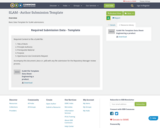
Basic Data Template for SLAM submissions
- Subject:
- Engineering
- Higher Education
- Manufacturing
- Material Type:
- Teaching/Learning Strategy
- Author:
- Richard Wysk
- Date Added:
- 11/16/2020

Basic Data Template for SLAM submissions

SLAM is a Learning Repository for Advanced Manufacturing Technology using 40 years of AMT materials contributed by Dr. Wysk and others willing to share their teaching materials. The intent of STAM is to improve AMT instruction and get new AMT methods into the classroom more quickly. Special thanks to NSF for their support of DUE-1841441.

The engineer of the year 2020 and beyond will require an increasingly broad set of technical and business skills. Today's technical environment already spans from product development to design to planning for manufacture to manufacture to qualification to marketing and to maintenance of a product. In the future, engineers will also address business requirements to include: marketing, capital equipment justification and procurement, pricing and capitalization. In general, engineers of the future will provide many of the business and technical integration requirements linking engineering and business. Our focus and presentation of the technologies of engineering will strongly be skewed toward how these activities fit into the manufacturing of a product but also with emphasis of design and planning for manufacturing. Integration (both functional where design is linked to manufacturing and informational where data is available to everybody) is key to future engineering success. Our presentation of materials in this repository will be directed toward this vision.

This course covers the mathematical foundations and state-of-the-art implementations of algorithms for vision-based navigation of autonomous vehicles (e.g., mobile robots, self-driving cars, drones). It provides students with a rigorous but pragmatic overview of differential geometry and optimization on manifolds and knowledge of the fundamentals of 2-view and multi-view geometric vision for real-time motion estimation, calibration, localization, and mapping. The theoretical foundations are complemented with hands-on labs based on state-of-the-art mini racecar and drone platforms. It culminates in a critical review of recent advances in the field and a team project aimed at advancing the state of the art.